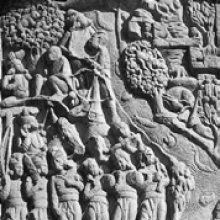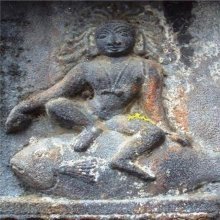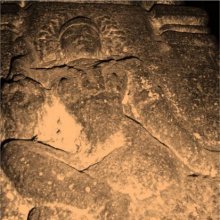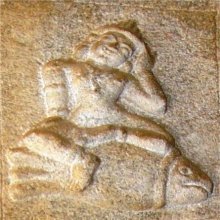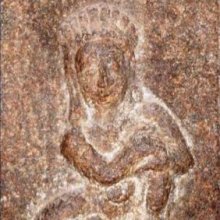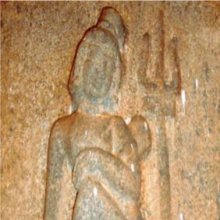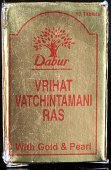Fish: 6 definitions
Introduction:
Fish means something in Hinduism, Sanskrit, the history of ancient India. If you want to know the exact meaning, history, etymology or English translation of this term then check out the descriptions on this page. Add your comment or reference to a book if you want to contribute to this summary article.
Images (photo gallery)
(+34 more images available)
In Hinduism
Natyashastra (theatrics and dramaturgy)
Source: Shodhganga: Elements of Art and Architecture in the Trtiyakhanda of the Visnudharmottarapurana (natya)The Fish is denoted by the Sanskrit term Matsya, whereas Matsyāvatāra refers to one the Daśāvatāra (“ten incarnations”) (of Lord Viṣṇu) to which are assign various hand gestures (in Indian Dramas), according to the Viṣṇudharmottarapurāṇa, an ancient Sanskrit text which (being encyclopedic in nature) deals with a variety of cultural topics such as arts, architecture, music, grammar and astronomy.—The word matsyāvatāra stands for the incarnation of fish of lord Viṣṇu. So, it is an authentic reason to create a shape of fish with hands to show this āvatāra. According to the Viṣṇudharmottarapurāṇa, the ardhacandra-hasta indicates the matsya-avatāra. Point to be noted here is that, only the single hand in ardhacandra does not look like a fish and it does not justify the name of this hasta.

Natyashastra (नाट्यशास्त्र, nāṭyaśāstra) refers to both the ancient Indian tradition (shastra) of performing arts, (natya—theatrics, drama, dance, music), as well as the name of a Sanskrit work dealing with these subjects. It also teaches the rules for composing Dramatic plays (nataka), construction and performance of Theater, and Poetic works (kavya).
Shilpashastra (iconography)
Source: Shodhganga: Elements of Art and Architecture in the Trtiyakhanda of the Visnudharmottarapurana (shilpa)Fish in a painting follow specific guidelines in the ancient Indian tradition of Painting (citra), according to the Viṣṇudharmottarapurāṇa, an ancient Sanskrit text which (being encyclopedic in nature) deals with a variety of cultural topics such as arts, architecture, music, grammar and astronomy.—According to the Viṣṇudharmottarapurāṇa, a picture having water or so to say showing water sources should be drawn with numerous fishes, tortoises and aquatic animals. [...] Thus, the Viṣṇudharmottarapurāṇa addresses various elements of nature, such as fish, since painting has much connection with time, mood and activity.

Shilpashastra (शिल्पशास्त्र, śilpaśāstra) represents the ancient Indian science (shastra) of creative arts (shilpa) such as sculpture, iconography and painting. Closely related to Vastushastra (architecture), they often share the same literature.
Yoga (school of philosophy)
Source: ORA: Amanaska (king of all yogas): A Critical Edition and Annotated Translation by Jason BirchA Fish (symbolizing freedom from the mind-net) is denoted by the Sanskrit term Mīna, according to the Amanaska Yoga treatise dealing with meditation, absorption, yogic powers and liberation.—Accordingly, as Īśvara says to Vāmadeva: “[...] When the wings, which are the in and out breaths and whose sphere of operation is all the senses, are cut off, the mind-bird being motionless [in the air], plummets. [The Yogin] becomes joyful like a fish (mīnavat) having torn [free from] the mind-net, whose threads are the breath and whose knots are the senses. [...]”.

Yoga is originally considered a branch of Hindu philosophy (astika), but both ancient and modern Yoga combine the physical, mental and spiritual. Yoga teaches various physical techniques also known as āsanas (postures), used for various purposes (eg., meditation, contemplation, relaxation).
Ayurveda (science of life)
Toxicology (Study and Treatment of poison)
Source: Shodhganga: Kasyapa Samhita—Text on Visha ChikitsaThe study of Fish (habitat, bites and treatment) refers to one of the topics dealt with in the Kāśyapa Saṃhitā: an ancient Sanskrit text from the Pāñcarātra tradition dealing with both Tantra and Viṣacikitsā—an important topic from Āyurveda which deals with the study of Toxicology (Viṣavidyā or Sarpavidyā).—The Kāśyapasaṃhitā gives deep insights in respect of different mantras as also the different varieties of snakes alongside with all the attendant details. It also deals in detail with different kinds of rat-bites, bites of twenty kinds of insects like spider, scorpion, centipede, fish and worms and their antidotes and long-term treatment regimen for various venomous bites
Agriculture (Krishi) and Vrikshayurveda (study of Plant life)
Source: Shodhganga: Drumavichitrikarnam—Plant mutagenesis in ancient IndiaFish (in Sanskrit: Mīna) is used in certain bio-organical recipes for plant mutagenesis, according to the Viśvavallabha-Vṛkṣāyurveda by Cakrapāṇi-Miśra (1580 CE): an encyclopedic work dealing with the principles of ancient Indian agriculture and horticulture.—Accordingly, “A seed that is cultivated in a mixture of the marrow, flesh and fat of a boar and fish (mīna) and the sap of Cyperus rotundus and sown grows and bears fruit”.

Āyurveda (आयुर्वेद, ayurveda) is a branch of Indian science dealing with medicine, herbalism, taxology, anatomy, surgery, alchemy and related topics. Traditional practice of Āyurveda in ancient India dates back to at least the first millenium BC. Literature is commonly written in Sanskrit using various poetic metres.
India history and geography
Source: Singhi Jain Series: Ratnaprabha-suri’s Kuvalayamala-katha (history)Fish were commonly depicted on the Saṃsāracakra paintings (representing scenes of human life), in ancient India, as mentioned in the Kathās (narrative poems) such as Uddyotanasūri in his 8th-century Kuvalayamālā (a Prakrit Campū, similar to Kāvya poetry).—Page 185.21 f.: Here follows a description of a printed scroll illustrating the Jaina conception of saṃsāracakra. [...] The saṃsāra-cakra illustrated the three worlds of hell, human world and the world of gods. [For example:] A man entering the sea to save some drowning relation; a man stealing others' money; a fisherman catching a haul of fish with his net.

The history of India traces the identification of countries, villages, towns and other regions of India, as well as mythology, zoology, royal dynasties, rulers, tribes, local festivities and traditions and regional languages. Ancient India enjoyed religious freedom and encourages the path of Dharma, a concept common to Buddhism, Hinduism, and Jainism.
See also (Relevant definitions)
Starts with: Fish belly, Fish catching coral tree, Fish eyes, Fish glue, Fish oil, Fish poison, Fish poison tree, Fish scale, Fish water, Fish-berry, Fish-bone cassia, Fish-fuddle tree, Fish-killer tree, Fish-poison bean, Fishbone fern, Fisherman, Fishfuddle, Fishing rod, Fishtail palm, Fishwort.
Ends with: Dwarfish, Fish belly, Fish oil, Golden Fishes, Salt fish.
Full-text (+2536): Matsya, Pathina, Rohita, Shakula, Timi, Rajiva, Mina, Maccha, Jhasha, Gargara, Matsyada, Shakalin, Shaphara, Sashalka, Matsyavatara, Matsyadhani, Minakshi, Laghugarga, Madarmada, Citravadala.
Relevant text
Search found 307 books and stories containing Fish; (plurals include: Fishes). You can also click to the full overview containing English textual excerpts. Below are direct links for the most relevant articles:
Village Folk-tales of Ceylon (Sri Lanka), vol. 1-3 (by Henry Parker)
Story 64 - The Heron And The Crab < [Part II (c) - Stories of the Durayas]
Story 53 - The Pots Of Oil < [Part II (b) - Stories of the Tom-tom Beaters]
Story 7 - The Turtle Dove < [Part I - Stories told by the Cultivating Caste and Vaeddas]
Mahabharata (English) (by Kisari Mohan Ganguli)
Section CXXXVII < [Apaddharmanusasana Parva]
Section L < [Anusasanika Parva]
Section LI < [Anusasanika Parva]
Amarakoshodghatana of Kshirasvamin (study) (by A. Yamuna Devi)
Fauna (7): Aquatic Animals < [Chapter 5 - Aspects of Nature]
Fauna (12): Synonyms added by Kṣīrasvāmin < [Chapter 5 - Aspects of Nature]
Economics (3): Goods of trade < [Chapter 3 - Social Aspects]
The Gospel of Buddha (by Paul Carus)
The Jataka tales [English], Volume 1-6 (by Robert Chalmers)
Jataka 75: Maccha-jātaka < [Book I - Ekanipāta]
Jataka 114: Mitacinti-jātaka < [Book I - Ekanipāta]
Jataka 288: Macch-Uddāna-jātaka < [Book III - Tika-Nipāta]
Folklore of the Santal Parganas
Chapter XVIII - The Laughing Fish < [Part I]
Chapter LXIX - Dukhu and His Bonga Wife < [Part I]
Chapter 15 - The Sons of the Raban Rājā < [Appendix]
Related products
(+14 more products available)
